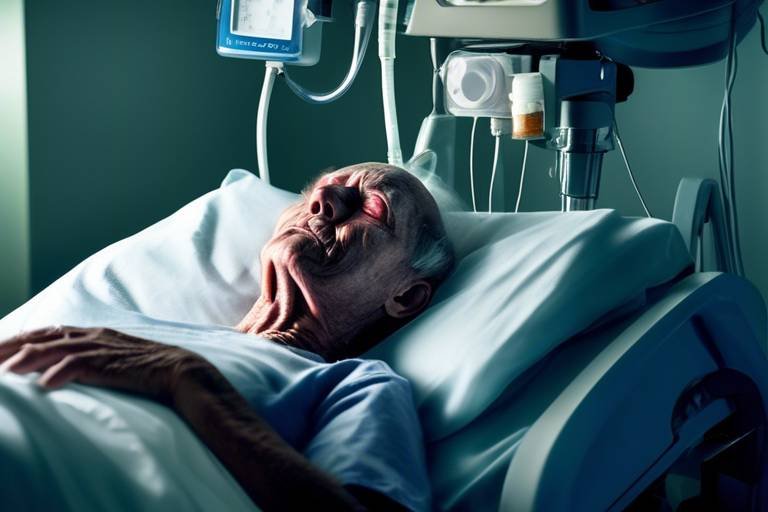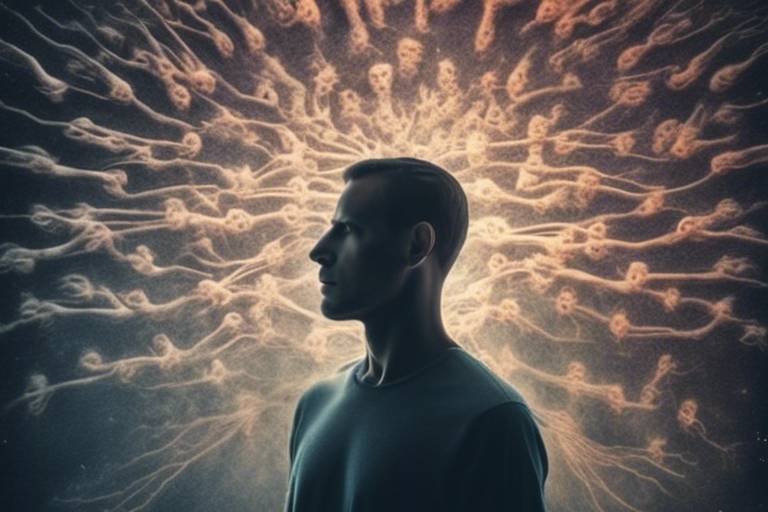The Question of Consciousness in Comatose Patients
Have you ever wondered what happens to the mind when a person is in a coma? It's a profound question that delves into the very essence of consciousness, a state that remains shrouded in mystery for many. Comatose patients are often viewed as being completely unresponsive, yet recent research suggests that the reality may be far more intricate. This article aims to explore the complexities surrounding consciousness in comatose patients, examining medical definitions, ethical implications, and the latest findings to better understand this profound and often misunderstood state of being.
A coma is not merely a deep sleep; it's a medical condition characterized by a prolonged state of unconsciousness. According to medical definitions, a coma occurs when a patient is unresponsive to external stimuli and lacks voluntary movement. There are various types of coma, including metabolic, traumatic, and drug-induced, each stemming from different physiological processes. For instance, a traumatic coma may arise from a severe head injury, while a metabolic coma could result from a lack of oxygen or severe illness. Understanding these distinctions is crucial in grasping the complexity of consciousness in these patients.
Identifying signs of consciousness in comatose patients can be challenging yet fascinating. Medical professionals often rely on various neurological assessments to gauge a patient's level of awareness. These assessments can include observing reflexive movements, responses to stimuli, and even brain activity through imaging techniques. Interestingly, some patients may exhibit subtle signs of consciousness that are easily overlooked. For example, a slight movement of the eyes or a change in heart rate in response to a familiar voice can indicate a deeper level of awareness than previously thought.
Neurological assessments are essential tools used by healthcare providers to evaluate the state of consciousness in comatose patients. These assessments often involve a series of tests designed to measure responsiveness and brain function. Techniques such as the Glasgow Coma Scale (GCS) provide a standardized way to assess the severity of coma based on verbal, motor, and eye-opening responses. The results can be pivotal in determining the appropriate course of treatment and predicting potential recovery outcomes.
Advancements in brain imaging technologies, such as functional Magnetic Resonance Imaging (fMRI) and Positron Emission Tomography (PET) scans, have revolutionized our understanding of consciousness in comatose patients. These tools allow researchers to visualize brain activity patterns that may indicate levels of awareness. For instance, studies have shown that some patients, when asked to imagine specific activities, exhibit brain activation similar to healthy individuals. This suggests that consciousness may persist even in the absence of overt behavior.
Behavioral responses in comatose patients can serve as critical indicators of consciousness. While some patients may appear completely unresponsive, others might display reflexive actions or slight movements that hint at awareness. However, interpreting these behaviors is fraught with challenges. For example, a patient may respond to pain with a grimace, but does that indicate consciousness, or is it merely a reflex? The fine line between involuntary responses and conscious awareness makes this area of study both complex and intriguing.
The ethical dilemmas surrounding comatose patients are profound and often heart-wrenching. Families and medical professionals face tough decisions regarding care, especially when it comes to end-of-life considerations. Questions about quality of life, the potential for recovery, and the moral implications of continuing life support can weigh heavily on loved ones. It's crucial to engage in open conversations about these issues, ensuring that the wishes of the patient, if known, are honored while also considering the emotional toll on families.
The field of consciousness research is rapidly evolving, with recent studies shedding light on potential recovery paths for comatose patients. Researchers are exploring innovative therapies and interventions that could enhance the likelihood of regaining consciousness. For instance, some studies have investigated the effects of sensory stimulation therapies, which involve exposing patients to sounds, smells, and tactile sensations to stimulate brain activity. These findings hold promise for improving patient outcomes and reshaping our understanding of recovery in comatose states.
Real-world case studies provide invaluable insights into the spectrum of consciousness in comatose patients. For example, one case involved a patient who emerged from a prolonged coma after years of unresponsiveness, shocking both their family and medical team. Such stories illustrate the complexities of consciousness and highlight the importance of continued research and exploration in this field. Each case serves as a reminder that recovery can be unpredictable, and hope should never be entirely extinguished.
As we look to the future of consciousness research in comatose patients, the potential for breakthroughs is exciting. Advances in technology and a deeper understanding of brain function may lead to new treatment modalities that enhance recovery prospects. Moreover, interdisciplinary collaboration between neurologists, ethicists, and rehabilitation specialists will be essential in navigating the complexities of care for these patients. The journey toward understanding consciousness in comatose patients is ongoing, and each step forward brings us closer to unraveling the mysteries of the human mind.
- What is a coma? A coma is a state of prolonged unconsciousness where a person is unresponsive to external stimuli.
- Can comatose patients hear or understand what is happening around them? Some research suggests that certain patients may retain a level of awareness, but it varies widely.
- What are the chances of recovery from a coma? Recovery depends on various factors, including the cause of the coma, duration, and the patient's overall health.
- How do doctors assess consciousness in comatose patients? Doctors use neurological assessments, brain imaging techniques, and observation of behavioral responses.
- What ethical dilemmas do families face regarding comatose patients? Families often grapple with decisions about life support, quality of life, and the potential for recovery.

Understanding Coma
Coma is one of those medical terms that often conjures up images of a person lying still, surrounded by beeping machines and worried family members. But what does it really mean? In simple terms, a coma is a state of prolonged unconsciousness where a person cannot be awakened and fails to respond to stimuli. It’s not just sleeping; it’s more like being in a deep, unresponsive state where the brain is unable to perform its usual functions. To truly grasp the complexities of a coma, we need to delve into its medical definitions, types, and the physiological processes that lead to this altered state of consciousness.
From a medical standpoint, a coma can be classified into several types, depending on the underlying cause. These causes can range from traumatic brain injuries to metabolic disorders, and even strokes. Each type has its own unique characteristics and implications for recovery. For instance, a traumatic coma often results from a physical injury to the brain, while a metabolic coma may arise from issues like liver failure or severe diabetes. Understanding these distinctions is crucial, as they can influence treatment options and the potential for recovery.
At its core, a coma occurs due to a disruption in the brain's normal functioning. This can happen when there is damage to the brain's cortex, which is responsible for higher-level functions such as awareness and responsiveness. Additionally, the brainstem, which controls basic life functions like breathing and heart rate, can also be affected. When these areas of the brain are compromised, the result is a loss of consciousness and awareness. It’s akin to a computer crashing; the system is still there, but it’s unable to perform any tasks or respond to commands.
In terms of physiological processes, a coma can be seen as a complex interplay of various factors. For example, when the brain is deprived of oxygen—due to a lack of blood flow or other reasons—it can lead to irreversible damage, pushing the patient into a comatose state. Similarly, the presence of toxins in the bloodstream can alter brain function, resulting in a similar outcome. Understanding these processes not only helps medical professionals diagnose the condition but also aids in determining the best course of action for treatment.
It’s important to note that not all comas are created equal. The depth and duration of a coma can vary significantly from one patient to another. Some individuals may emerge from a coma within days, while others may remain in this state for weeks, months, or even years. This variability adds another layer of complexity to the question of consciousness in comatose patients. Are they aware of their surroundings? Can they hear the voices of loved ones? These questions linger in the minds of families and medical professionals alike, driving the need for ongoing research in this field.
In summary, understanding coma is not just about knowing its definition; it’s about recognizing the intricate web of factors that contribute to this profound state of being. As we continue to explore the nuances of coma, we must also consider the implications for those who find themselves in this mysterious realm of consciousness—or lack thereof.

Signs of Consciousness
When we think about consciousness, especially in the context of comatose patients, it can feel like navigating through a foggy landscape. What are the signs that someone, despite being in a coma, might still have some level of awareness? This question is not just a matter of academic interest; it touches the hearts of families and medical professionals alike. Understanding these signs can be crucial for determining the appropriate care and treatment options.
One of the most fascinating aspects of consciousness in comatose patients is the subtlety of the signs that may indicate some level of awareness. Medical professionals often rely on a combination of neurological assessments and behavioral responses to gauge consciousness. These assessments can range from simple reflex tests to more complex imaging techniques that reveal brain activity.
Neurological assessments are like the detective work of medicine. They help uncover clues about a patient's state of consciousness. For instance, doctors might use the Glasgow Coma Scale (GCS), a widely recognized tool that scores a patient's eye, verbal, and motor responses. The scores can range from 3 to 15, with lower scores indicating deeper levels of unconsciousness. However, a higher score does not always guarantee full consciousness. This is where things get tricky; a patient may appear to be unresponsive yet still possess some awareness beneath the surface.
Advanced brain imaging techniques, such as functional Magnetic Resonance Imaging (fMRI) and Positron Emission Tomography (PET) scans, have revolutionized our understanding of consciousness in comatose patients. These technologies allow researchers to see brain activity in real-time, revealing patterns that may suggest a flicker of awareness. For example, a patient who is deemed unresponsive may still show brain activity when asked to imagine specific scenarios, indicating that their mind is active even if their body is not responding.
Behavioral responses can also offer critical insights. Some patients may exhibit reflexive actions—like blinking or moving their limbs—when stimuli are applied. While these actions can sometimes be misinterpreted as signs of consciousness, they may also be mere reflexes, complicating the picture. For instance, a patient might respond to painful stimuli, which can be a sign of brain activity, but it doesn't necessarily mean they are aware of their surroundings. This ambiguity makes it essential for medical professionals to tread carefully when interpreting these behaviors.
In summary, recognizing the signs of consciousness in comatose patients is a complex and nuanced endeavor. While neurological assessments and advanced imaging techniques provide valuable insights, the interpretation of behavioral responses remains a challenging aspect of this field. As our understanding of consciousness evolves, so too will our ability to identify and support those who may still be aware, even in the depths of a coma.
- What is the Glasgow Coma Scale? The Glasgow Coma Scale is a scoring system used to assess a patient's level of consciousness based on their eye, verbal, and motor responses.
- Can comatose patients hear or understand what is happening around them? Some studies suggest that patients may retain some level of awareness, but this varies greatly from individual to individual.
- What are the ethical implications of treating comatose patients? Ethical dilemmas often arise regarding end-of-life decisions and the quality of life for patients who may never regain full consciousness.
- How can brain imaging techniques help in assessing consciousness? Techniques like fMRI and PET scans can reveal brain activity patterns that suggest a patient may have some level of awareness, even when they appear unresponsive.

Neurological Assessments
When it comes to understanding consciousness in comatose patients, play a crucial role. These assessments are not just a series of tests; they are windows into the complex workings of the brain, allowing medical professionals to gauge the level of awareness and responsiveness in patients who seem to be in a deep state of unconsciousness. Imagine trying to decipher a book written in an unfamiliar language; that’s what assessing consciousness can feel like for doctors. They rely on a variety of techniques and tools to piece together the puzzle of a patient’s neurological status.
One of the primary methods used in these assessments is the Glasgow Coma Scale (GCS). This scale provides a standardized way of measuring a patient's level of consciousness based on their ability to respond to verbal commands, physical stimuli, and their eye-opening responses. Each of these responses is scored, and the total score can range from 3 to 15, with lower scores indicating a more severe impairment of consciousness. Here’s a quick breakdown of the GCS:
| Score | Level of Consciousness |
|---|---|
| 3-8 | Severe coma |
| 9-12 | Moderate coma |
| 13-15 | Mild coma or full consciousness |
In addition to the GCS, healthcare providers may utilize neurological imaging techniques to gain deeper insights into brain activity. Technologies like functional Magnetic Resonance Imaging (fMRI) and Positron Emission Tomography (PET) scans have revolutionized our understanding of brain function. These imaging methods allow doctors to visualize areas of the brain that are active during specific tasks or stimuli, even in patients who are unable to communicate or respond. For instance, a patient may not physically react, but an fMRI could show that their brain is processing auditory information when they hear familiar voices. This is akin to finding a hidden treasure chest in a vast ocean; the treasure here is the evidence of consciousness that can be detected even when outward signs are absent.
However, interpreting these assessments is not always straightforward. The challenge lies in distinguishing between reflexive actions and genuine conscious responses. For example, a patient may exhibit movements such as blinking or grasping, which could be reflexive rather than indicative of awareness. This ambiguity raises profound questions about what it truly means to be conscious. Are these actions mere biological responses, or do they hint at a flicker of awareness? Medical professionals must tread carefully, balancing their interpretations with compassion and understanding.
Ultimately, neurological assessments provide a framework for understanding the complex landscape of consciousness in comatose patients. They are not just tools for diagnosis but are also crucial in guiding treatment decisions and setting realistic expectations for families. As research continues to evolve, these assessments will likely become even more sophisticated, offering hope and clarity in what can often feel like a fog of uncertainty.

Brain Imaging Techniques
When it comes to understanding consciousness in comatose patients, have emerged as a game-changer. These advanced technologies allow us to peek inside the mind, revealing patterns of brain activity that can provide valuable insights into a patient's state of awareness. Imagine being able to visualize the flickers of thought and feeling, much like watching the glowing embers of a fire that suggest a flame still burns beneath the surface.
Two of the most prominent imaging techniques used in this field are Functional Magnetic Resonance Imaging (fMRI) and Positron Emission Tomography (PET). Both of these methods utilize different principles to capture brain activity, yet they share a common goal: to assess whether there is any level of consciousness present in patients who appear unresponsive.
fMRI works by detecting changes in blood flow within the brain. When a particular area of the brain is active, it requires more oxygen, which leads to an increase in blood flow to that region. This technique is incredibly useful because it can show real-time brain activity, helping researchers identify areas that may still be functioning even when the patient is in a coma. For example, studies using fMRI have shown that some patients can respond to verbal commands or even imagine specific activities, indicating a level of consciousness that was previously undetectable.
On the other hand, PET scans work by measuring metabolic processes in the brain. A small amount of radioactive material is injected into the patient, which then accumulates in areas of high activity. This technique allows for a more comprehensive view of how different regions of the brain communicate with each other. In some cases, PET scans have revealed surprising levels of brain activity in patients diagnosed as being in a vegetative state, suggesting that they may have a hidden awareness of their surroundings.
However, interpreting the results of these imaging techniques can be a complex endeavor. For instance, just because a patient shows brain activity does not necessarily mean they are consciously aware. It's akin to a light flickering in a room; it might suggest someone is home, but it doesn't confirm their presence. Therefore, medical professionals must consider these findings alongside other assessments and observations to form a holistic view of the patient's condition.
In conclusion, brain imaging techniques like fMRI and PET scans are revolutionizing our understanding of consciousness in comatose patients. By offering a glimpse into the brain's inner workings, these technologies challenge our perceptions and open new avenues for treatment and care. As research continues to evolve, we may one day unlock the mysteries of consciousness, providing hope for families and patients alike.

Behavioral Responses
The realm of in comatose patients is both fascinating and perplexing. While these individuals may appear unresponsive on the surface, subtle signs can often suggest varying degrees of consciousness. It’s like trying to decipher a book with missing pages; you have to piece together the clues to understand the story. Medical professionals often look for specific reflexive actions that might indicate some level of awareness—these actions can range from simple reflexes to more complex movements.
One of the primary challenges in interpreting these behaviors lies in the fact that not all movements are indicative of conscious thought. For instance, a patient might exhibit a startle reflex in response to loud noises, which is a natural neurological response rather than a sign of conscious awareness. However, when a comatose patient reacts to stimuli in a more deliberate manner—such as squeezing a hand when asked—this can suggest a deeper level of consciousness. It’s essential for caregivers and families to understand the nuances of these responses, as they can often lead to false hope or misinterpretation of a patient’s condition.
To further illustrate the complexity of behavioral responses, consider the following examples:
- Purposeful Movements: Actions such as reaching for a loved one or following a moving object with the eyes can indicate a level of awareness.
- Non-Purposeful Movements: Reflexive movements, like twitching or jerking, may occur without any conscious intention behind them.
- Response to Pain: A patient may withdraw from a painful stimulus, which can be a sign of awareness, though it is often reflexive.
Moreover, advancements in technology are paving the way for better understanding of these behavioral responses. For example, researchers are utilizing brain imaging techniques to observe brain activity in response to external stimuli, which can provide insight into whether a patient is truly aware of their surroundings. This intersection of technology and medicine is akin to opening a window into the mind of a comatose patient, allowing us to glimpse the potential for consciousness that may lie beneath the surface.
Ultimately, the interpretation of behavioral responses in comatose patients requires a delicate balance of scientific knowledge and compassionate understanding. Families often grapple with the emotional weight of these signs, as they can spark hope or despair. It’s crucial for medical professionals to communicate clearly with families about what these responses may mean, ensuring that they have a realistic understanding of their loved one’s condition. In the end, the journey of deciphering consciousness in comatose patients is not just a medical challenge, but a profound exploration of the human experience itself.
- What are the signs that a comatose patient may be conscious? Look for purposeful movements, eye tracking, and responses to stimuli.
- How do medical professionals assess consciousness in comatose patients? Through neurological assessments and advanced imaging techniques.
- Can comatose patients recover their consciousness? Yes, recovery is possible, but it varies greatly among individuals.
- What ethical dilemmas arise in the care of comatose patients? Decisions about end-of-life care and the quality of life are significant concerns.

Ethical Considerations
The ethical landscape surrounding the care of comatose patients is a complex tapestry woven with threads of compassion, medical responsibility, and the profound uncertainty of consciousness. Families often find themselves standing at a crossroads, grappling with heart-wrenching decisions that can define the life and dignity of their loved ones. Should they pursue aggressive treatment, or is it more humane to consider palliative care? These questions are not just medical; they are deeply personal and ethical.
One of the most pressing ethical dilemmas involves the concept of quality of life. What does it mean for a patient who is unresponsive, yet may possess some level of consciousness? Medical professionals and families must weigh the potential for recovery against the likelihood of a life that may be filled with pain or suffering. This brings us to the issue of informed consent. In many cases, comatose patients cannot express their wishes, leaving families to interpret what their loved ones would have wanted. This can lead to conflicts among family members, healthcare providers, and even legal representatives.
Furthermore, the question of resource allocation emerges. In a healthcare system where resources are finite, should we invest in the care of those in a coma, or should those resources be directed towards patients with a clearer path to recovery? This dilemma often forces healthcare professionals to navigate a tightrope of ethical responsibility, balancing the needs of individual patients against the broader needs of society.
To further complicate matters, the definitions of death and consciousness are not universally agreed upon. The line between life and death can be blurred in comatose patients, raising questions about when it is appropriate to declare someone deceased. This is particularly relevant in cases involving organ donation, where timing can be crucial. The ethical implications of such decisions can be staggering, affecting not only the patients but also their families and the medical community as a whole.
In navigating these ethical waters, it's essential for families and healthcare providers to engage in open dialogue. This can help clarify values and preferences, making the decision-making process more collaborative. Establishing advanced directives while a patient is still capable of making their wishes known can also alleviate some of the ethical burdens faced by families later on.
Ultimately, the ethical considerations surrounding comatose patients are a reflection of our values as a society. They challenge us to confront our beliefs about life, death, and the essence of consciousness itself. As research continues to evolve, so too will our understanding of these patients, potentially reshaping the ethical frameworks that guide our decisions.
- What is the primary ethical dilemma in treating comatose patients?
The primary dilemma often revolves around the quality of life versus the potential for recovery, leading families and medical professionals to make challenging decisions about care.
- How can families prepare for decisions regarding comatose loved ones?
Establishing advanced directives and having open conversations about wishes while the patient is still capable can greatly assist in future decision-making.
- What role does informed consent play in this context?
Informed consent becomes complicated when patients are unable to express their wishes, placing the burden on families to interpret what their loved ones would want.

Recent Research Advances
In the ever-evolving field of neuroscience, recent research has shed light on the enigmatic nature of consciousness, particularly in comatose patients. Scientists and medical professionals have been delving deep into understanding how consciousness can flicker to life even in the most severe states of unresponsiveness. One of the most exciting developments has been the use of advanced brain imaging techniques, which have opened a window into the minds of patients previously thought to be entirely unaware of their surroundings.
Studies utilizing functional Magnetic Resonance Imaging (fMRI) and Positron Emission Tomography (PET) scans have revealed that some comatose patients exhibit brain activity patterns similar to those of conscious individuals. For instance, researchers have discovered that when asked to imagine specific activities, such as playing tennis or walking through their home, certain patients show distinct brain responses. This suggests that there may be a level of awareness present, even if the patient cannot physically respond. Such findings challenge the traditional definitions of consciousness and raise profound questions about the nature of awareness itself.
Moreover, a groundbreaking study published in a leading medical journal highlighted the potential for recovery in patients diagnosed with a minimally conscious state (MCS). These patients often display inconsistent yet reproducible signs of awareness. The research indicated that with targeted rehabilitation and therapeutic interventions, some individuals have shown remarkable improvements in their ability to respond to stimuli. This raises hope for families and caregivers who have long grappled with the uncertainty surrounding their loved ones' conditions.
To further illustrate the advances in this field, consider the following table that summarizes recent findings from various studies on consciousness in comatose patients:
| Study | Findings | Implications |
|---|---|---|
| Smith et al. (2022) | fMRI detected brain activity in 30% of comatose patients during mental imagery tasks. | Possible awareness despite lack of physical response. |
| Jones & Taylor (2023) | Patients in MCS showed significant improvement with structured rehabilitation. | Potential for recovery through targeted therapies. |
| Lee et al. (2023) | Use of PET scans revealed distinct brain patterns in response to auditory stimuli. | Indicates some level of cognitive processing. |
As we continue to unravel the complexities of consciousness, ethical considerations also arise. Families are often faced with the heart-wrenching dilemma of making decisions about the care of their loved ones. The emotional weight of these decisions is compounded by the uncertainty of the patient's awareness. Understanding the research advances in this field is crucial, as it informs not only medical practices but also the emotional and ethical landscapes surrounding care for comatose patients.
Looking ahead, the future of consciousness research in comatose patients is promising. With ongoing studies aimed at refining our understanding of brain activity and consciousness, we may soon uncover new methods for rehabilitation and support. The integration of technology and neuroscience may pave the way for breakthroughs that could significantly enhance patient outcomes, offering hope to families and medical professionals alike.
- What is a coma? A coma is a state of prolonged unconsciousness where a person cannot be awakened and fails to respond to stimuli.
- Can comatose patients hear us? Some studies suggest that patients may retain some level of auditory awareness, although responses can vary widely.
- What are the signs of consciousness in comatose patients? Indicators can include eye movement, brain activity detected through imaging, and reflexive responses to stimuli.
- How can medical professionals assess consciousness? Neurological assessments, brain imaging techniques, and behavioral responses are used to evaluate consciousness levels.
- What are the ethical considerations in treating comatose patients? Families must navigate complex decisions regarding care, quality of life, and potential recovery, often guided by the latest research findings.

Case Studies
Case studies provide a fascinating window into the complex and often enigmatic world of consciousness in comatose patients. Each case tells a unique story, showcasing the spectrum of consciousness and the potential for recovery. For instance, one remarkable case involved a young man who suffered a traumatic brain injury after a car accident. Initially diagnosed as being in a persistent vegetative state, he exhibited no signs of awareness for several months. However, through the use of advanced imaging techniques, doctors discovered subtle brain activity patterns that indicated some level of consciousness. This revelation led to a reevaluation of his condition, and eventually, he began to show signs of responsiveness, such as following simple commands and even communicating through eye movements.
Another compelling example comes from a middle-aged woman who fell into a coma due to a severe stroke. Her family was devastated, facing the heart-wrenching decision of whether to continue life support. Fortunately, a neurologist recommended a series of neurological assessments and brain imaging tests. The results revealed that she had retained some degree of cognitive function, which was not evident through traditional assessments. Over time, she began to regain consciousness and could recognize family members, marking a miraculous recovery that defied initial expectations.
These case studies underscore the importance of not merely relying on conventional assessments to determine a patient's state of consciousness. They highlight how innovative approaches and technologies can uncover hidden levels of awareness, challenging our understanding of what it means to be "awake." In fact, the field is evolving, and researchers are continually working to refine the methods used to assess consciousness. This evolution is crucial not only for the patients but also for the families who face the emotional burden of making critical decisions regarding care and treatment.
Additionally, these stories emphasize the ethical dilemmas that families and medical professionals often confront. When faced with the uncertainty of a loved one's consciousness, decisions about care can become incredibly complex. The emotional weight of these decisions is compounded by the hope that recovery is possible, as illustrated by the aforementioned cases. Each recovery journey is unique, and while some patients may regain full consciousness, others may experience only partial awareness, leading to further ethical considerations about quality of life and the appropriateness of ongoing care.
As we continue to explore the realm of consciousness in comatose patients, these case studies serve as a poignant reminder of the resilience of the human spirit. They push us to question our definitions of consciousness and challenge us to consider the implications of our findings. The stories of recovery not only inspire hope but also pave the way for future research, ultimately contributing to a more profound understanding of consciousness in all its complexities.
- What is the difference between a coma and a persistent vegetative state? A coma is a state of unresponsiveness where a patient cannot be awakened, while a persistent vegetative state involves a lack of awareness but preserved autonomic functions.
- Can comatose patients hear or understand what is happening around them? Some studies suggest that certain patients may retain some level of awareness despite being unresponsive, but this varies widely among individuals.
- What technologies are used to assess consciousness in comatose patients? Advanced imaging techniques like fMRI and PET scans are commonly used to evaluate brain activity and assess levels of consciousness.
- How do families cope with the uncertainty of a loved one's condition? Families often seek support from healthcare professionals, counseling services, and support groups to navigate the emotional challenges of caring for a comatose patient.

Future Directions
The exploration of consciousness in comatose patients is a rapidly evolving field, and as we gaze into the future, the possibilities seem both exciting and daunting. Researchers are tirelessly working to unravel the mysteries of the mind, especially in cases where patients appear unresponsive. One of the most promising avenues of research is the integration of advanced neuroimaging techniques with artificial intelligence. Imagine a world where AI can analyze brain activity patterns and predict potential recovery trajectories for comatose patients. This could revolutionize how we approach treatment and rehabilitation.
Moreover, the development of neurostimulation therapies is gaining traction. These therapies aim to stimulate brain regions associated with consciousness, potentially awakening dormant pathways. Studies have shown that targeted stimulation can lead to improvements in responsiveness, suggesting that there is a flicker of consciousness even in the most severely affected patients. As we refine these techniques, we may discover new ways to engage with patients who have long been thought to be unreachable.
Another exciting direction is the growing interest in biomarkers of consciousness. Researchers are investigating specific biological indicators that could signal varying levels of awareness in comatose patients. By identifying these biomarkers, we could develop more accurate diagnostic tools that help differentiate between different states of consciousness. This would not only enhance our understanding of patient conditions but also inform treatment decisions, ensuring that care is tailored to individual needs.
Additionally, ethical considerations will continue to play a critical role in shaping future research. As we uncover more about consciousness, the implications for patient rights and decision-making become increasingly complex. Families and medical professionals will need to navigate these waters carefully, balancing hope with realism. Future studies will likely focus on developing frameworks that guide ethical decision-making in light of new findings, ensuring that patients' dignity and autonomy are respected.
In summary, the future of consciousness research in comatose patients is brimming with potential. With advancements in technology, a deeper understanding of the brain, and a commitment to ethical practice, we stand on the brink of breakthroughs that could redefine our approach to care. As we continue to explore these uncharted territories, the hope is that we can illuminate the path for patients and families, offering insights that resonate far beyond the clinical setting.
- What is consciousness? Consciousness refers to the state of being aware of and able to think about one's own existence, thoughts, and surroundings.
- Can comatose patients hear what is happening around them? While it is difficult to determine the level of awareness in comatose patients, some studies suggest that they may retain some level of auditory perception.
- What are the signs of recovery in comatose patients? Signs may include increased responsiveness to stimuli, purposeful movements, and the ability to follow simple commands.
- How do doctors assess consciousness in comatose patients? Doctors use various neurological assessments, imaging techniques, and behavioral observations to evaluate the level of consciousness.
- What ethical dilemmas arise in the care of comatose patients? Ethical dilemmas can include decisions about life support, quality of life considerations, and the wishes of family members versus medical advice.
Frequently Asked Questions
- What is a coma?
A coma is a profound state of unconsciousness where a person is unresponsive to their environment. It can result from various causes, including traumatic brain injuries, strokes, or drug overdoses. In this state, patients do not exhibit wakefulness or awareness, making it a complex and often misunderstood condition.
- Can comatose patients hear or understand what is happening around them?
There is ongoing debate and research regarding this question. Some studies suggest that certain comatose patients may retain some level of awareness and can respond to auditory stimuli, while others may not have any conscious awareness at all. Advanced brain imaging techniques have revealed that some patients show brain activity in response to familiar voices, indicating potential awareness.
- What are the signs that a comatose patient might have some level of consciousness?
Signs of potential consciousness can include reflexive movements, changes in heart rate in response to stimuli, and specific brain activity patterns observed through imaging techniques. Neurological assessments often play a crucial role in identifying these indicators, although interpreting them can be challenging.
- How do doctors assess consciousness in comatose patients?
Doctors use various neurological assessments, including the Glasgow Coma Scale (GCS), to evaluate a patient's level of consciousness. Additionally, advanced imaging techniques like fMRI and PET scans help visualize brain activity, providing insights into the patient's conscious awareness.
- What ethical considerations arise in the care of comatose patients?
Families and medical professionals face numerous ethical dilemmas when making decisions about the care of comatose patients. These include considerations about end-of-life care, the patient's quality of life, and the potential for recovery. Balancing hope for recovery with the realities of the patient's condition is a delicate process.
- Are there any recent advances in research on consciousness in comatose patients?
Yes, recent research has focused on understanding the spectrum of consciousness in comatose patients, exploring potential recovery paths, and improving assessment techniques. Studies have shown that some patients may regain consciousness after long periods, challenging previous assumptions about coma and recovery.
- What future directions are being explored in consciousness research?
Future research aims to develop more effective diagnostic tools and treatment options for comatose patients. Scientists are investigating the underlying mechanisms of consciousness and exploring innovative therapies that could enhance recovery outcomes, potentially transforming how we approach care for these patients.


















